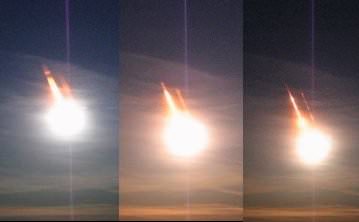[/caption] Officials are now saying the bright fireball seen over Virginia in the US on Sunday was probably a natural meteor event and not part of a Russian rocket, a reversal from yesterday's initial analysis. Space.com reported that an official from the U.S. Naval Observatory believed the loud boom and flash of light seen in the skies over Norfolk and Virginia Beach was likely the second stage of the Soyuz rocket that launched Expedition 19 to the International Space Station last Thursday. However, U.S. Strategic Command has since reported that the rocket re-entered Earth's atmosphere near Taiwan, on the other side of the world, several hours after the reports of the fireball. So both its timing and entry location rule out the rocket as the explanation for the fireball. But the investigation is continuing to determine exactly what the object was.
The Joint Space Operations Center at Vandenberg Air Force Base in California also confirmed "the 'bright light' that was reported on the East Coast on Sunday, 29 March at 9:45 p.m. EST was not a result of any trackable manmade object on reentry," according to Patricia Phillips at the Space News Examiner.
Space rocks the size of small cars plunge into Earth's atmosphere several times a year, typically burning up before reaching the ground. "The atmosphere is very good at protecting us from falling rocks," said Bill Cooke of NASA's Marshall Space Flight Center. Ones that do reach the ground go unreported since they fall over uninhabited areas or in the ocean.
A few space rocks do occasionally make it to the surface though. In recent years, pieces of a bolide were found after a
meteor event in western Canada,
and fragments of a meteor that originated from an asteroid that blew up over the skies of Africa last October
were also recovered in the Sudanese desert.
Sources: Space.com, Space News Examiner
 Universe Today
Universe Today
